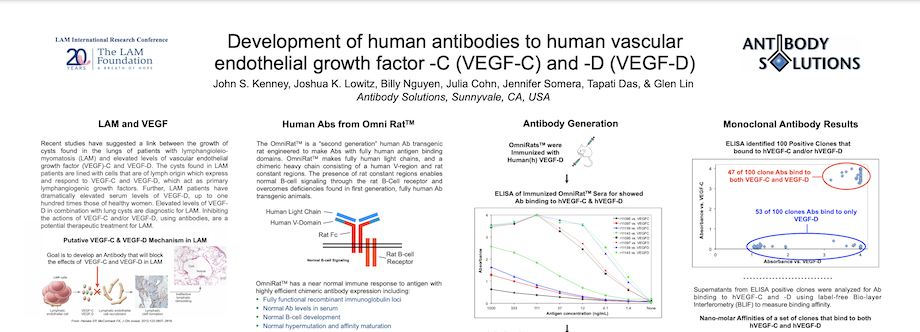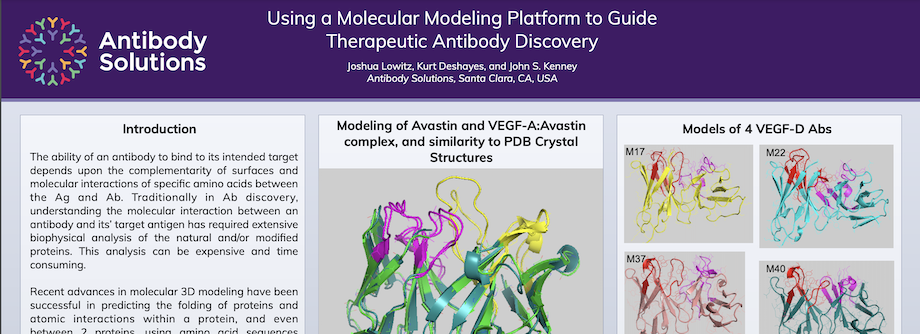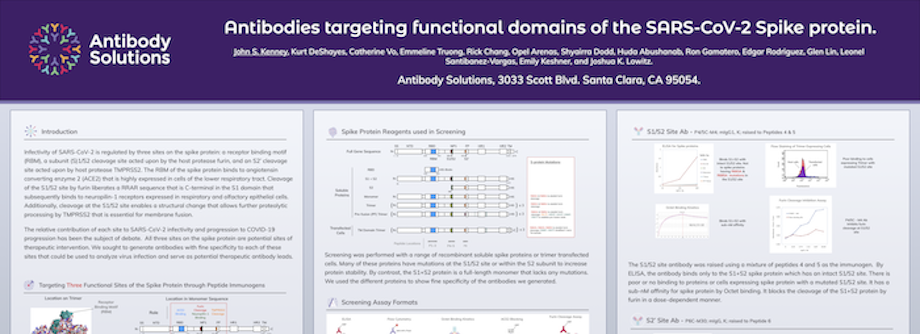1 min read

Recent studies have suggested a link between the growth of cysts found in the lungs of patients with lymphangioleiomyomatosis (LAM) and elevated levels of vascular endothelial growth factor (VEGF)-C and VEGF-D. The cysts found in LAM patients are lined with cells that are of lymph origin which express and respond to VEGF-C and VEGF-D, which act as primary lymphangiogenic growth factors. Further, LAM patients have dramatically elevated serum levels of VEGF-D, up to one hundred times those of healthy women. Elevated levels of VEGFD in combination with lung cysts are diagnostic for LAM. Inhibiting the actions of VEGF-C and/or VEGF-D, using antibodies, are a potential therapeutic treatment for LAM.
Summary
Human monoclonal antibodes have been raised that bind with nano-molar or better affinity to both hVEGF-C and hVEGF-D, and only to VEGF-D. The Abs provide a pool of potential candidates for the development of a therapeutic Ab to block the effects of hVEGF-C and/or hVEGF-D in LAM Disease.
Download this poster
We invite you to download our poster that details this research study, including our antibody discovery strategy as well as the Spike protein reagents, screening assay formats, and more that we utilized.
Authors
John S. Kenney, Joshua K. Lowitz, Billy Nguyen, Julia Cohn, Jennifer Somera, Tapati Das, & Glen Lin Antibody Solutions, Sunnyvale, CA, USA

Written by Antibody Solutions Research Team
Filter by Keyword
- Posters (21)
- Publications (15)
- Therapeutic Monoclonal Antibodies (4)
- Monoclonal (3)
- Multi-meric Membrane (3)
- Multi-pass transmembrane (3)
- Transgenic Animals (3)
- ELISAs (2)
- Human Therapeutic Antibodies (2)
- Hybridoma (2)
- SARS-CoV-2 (2)
- APOBEC3G (1)
- ARMER (1)
- ATX-GX (1)
- Alloy Therapeutics (1)
- Antibody Discovery (1)
- Antibody Generation (1)
- BRCA2 (1)
- CEM15 (1)
- Cadherin-11 (1)
- Carcinogenesis (1)
- Conditioned Media (1)
- Critical Reagents (1)
- Cystine Knot Peptides (1)
- D Protein (1)
- DLL4 (1)
- Fully Human (1)
- HIV-1 (1)
- HSA (1)
- IL-1 alpha (1)
- Immune B-cells (1)
- Immunization (1)
- Knottins (1)
- L-amino acids (1)
- L-selectin (1)
- LAM (1)
- LBAs (1)
- LOXL2 (1)
- Lymphangioleiomyomatosis (1)
- McAbs (1)
- OmniAb (1)
- OmniRat (1)
- PNAd (1)
- Pharmacokinetic (PK) (1)
- Prolactin (1)
- Secretion Capture Report Web (1)
- Stereochemistry (1)
- Therapeutic Targets (1)
- Tissue Culture (1)
- Transgenic H2L2 Mice (1)
- VEGF-A (1)
- VEGF-C (1)
- VEGF-D (1)
- p53 (1)




